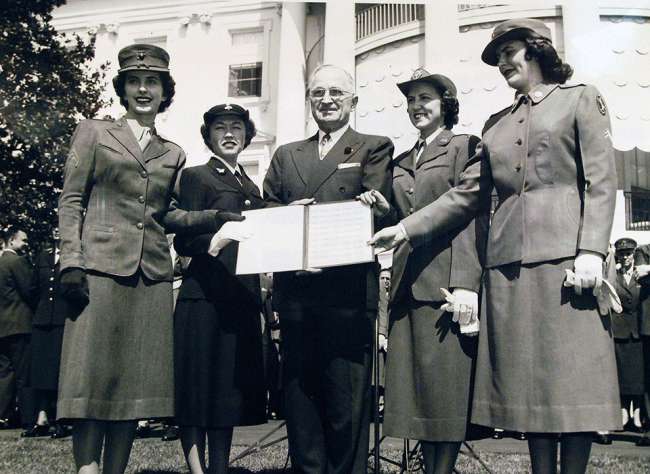Without interpreters and translators, the Nuremberg Trial as we know it would have been impossible. The Allied nations agreed in August 1945 that the trials to prosecute Nazi war crimes should be carried out fairly and expeditiously. In order to do so, the trial needed to be conducted simultaneously in English, Russian, German, and French for the American, British, Russian, and French judges and prosecutors and also for the German defendants and their defense counsel. Language professionals一translators and interpreters一were the unspoken heroes of the Nuremberg Trials.
Translators and interpreters played a critical role in the mechanics of the trials beginning with the main trial, which was conducted over a 10 month period from November 20,1945 to October 1, 1946. The proceedings took place in 210 trial days. There was so much material presented during the trial that the trial’s published transcripts fill 42 volumes. It is sometimes referred to as “the trial of six million words.” The trial was arguably the most important trial of the twentieth century, during which the four Allied powers tried Nazi leaders for crimes they committed during the war including murder, enslavement, deportation, and other inhumane acts committed against civilian populations, which would be termed “crimes against humanity.” Out of the 24 accused men, 22 stood trial.
The two very different tasks of interpretation and translation were both critical functions during the Nuremberg Trials. Translation is performed on written works, taking a text in one language and rendering it in another. Translation usually allows for edits and time for consideration and reference. Interpretation is performed on the spoken word, and although there are different types of interpretation, it is often performed extemporaneously without time to consult sources or incorporate edits. Both translation and interpretation were used every moment at Nuremberg.
There are a few ways the tribunal could have handled the different languages used during the proceedings. The standard way would have employed “consecutive translation.” One speaker would deliver remarks in German while interpreters took notes. After the speaker was done, one interpreter would interpret into French, followed by an interpretation in Russian, and then in English. If this method had been chosen, the trial would have lasted four times as long, with every line of testimony, questioning, and sentencing being spoken aloud four times. The IMT knew this was not practical. With “simultaneous translation,” the interpreters wait for a unit of meaning and then deliver that unit of meaning into another language. It is, of course, not truly simultaneous, but there is a lag in translation of ideally only six to eight seconds. At first it was thought that this type of translation was not feasible. To listen in one language and speak in another seemed impossible.
Prior to the Nuremberg Trials, only limited experiments had been done in simultaneous translation. When looking at the history of interpretation, before World War I, this type of interpretation was not deemed necessary because the official diplomatic language was French. At the Paris Peace Conference and the League of Nations, the British succeeded in convincing the participants to conduct the proceedings in English. Consequently, at these venues, “whispered interpretation was used,” where one literally whispered a translation into a recipient’s ear. Texts were usually pre-translated and then read, or in the case of speeches, they might be delivered and then several translations would be provided in succession at the conclusion of the speech. Star interpreters like Andre Kaminker, who interpreted a 1934 Hitler speech for French radio, could interpret an hour and a half speech without notes. But this type of interpretation was inefficient; one would need to listen to a full speech in a foreign language before hearing the familiar translation.
The first school for interpreters, based in Geneva, Switzerland, did not open until 1941. But some innovation had been brewing for more than a decade in the business community. In the 1920s, an idea was patented by Filene-Findlay (a businessman and an engineer) and brought to IBM. They manufactured the “IBM Hushaphone Filene-Findlay System” or the “International Translator System,” which was used at the International Labor Conference in Geneva in 1927. This was the system that brought the words of the Nuremberg Trial to life. Although the system was not new, the way in which it was employed was very innovative.
Leon Dostert is widely credited as the one who brought the system to the attention of American judges who were handling the administration of the trial. Dostert, a famous linguist and Eisenhower’s personal translator, was the head of the IMT’s Translation Division. He had an office at the Pentagon from which he began to recruit interpreters, mainly for English and German, but for other languages as well. The French and the Russians were to be responsible for providing their own language staff, and the United States was to share English language staff with the British. In the end, the Americans did most of the heavy lifting in terms of recruiting, housing, and also paying the interpreters and translators.
Dostert assumed command of the hiring process on October 1, 1945, just weeks ahead of the trial’s opening on November 20. Word of mouth and publicity about the trial helped Dostert to recruit, as did information distributed to government offices. Army personnel were also requisitioned for potential reassignment. He began testing candidates for general language proficiency in Washington, DC, and those who passed were selected to be sent to Nuremberg. Dostert tested all of the language personnel—the interpreters, but also translators and stenographers—and both civilian and military personnel reported to his office. The tests involved naming 10 trees, 10 car parts, 10 farm tools, etc. in two languages to test interpreters for a good general knowledge of the language in a variety of fields. Personnel were also recruited in Europe since a tremendous number of translators were needed to translate the mountains of documents that the trial generated.
While the staff was being assembled, the courtroom in Nuremberg was being reconstructed after suffering heavy damage during the war. Once the language personnel were hired, there was initially no way to train them on site using the interpretation equipment. The equipment itself was tough to round up. IBM agreed to supply the equipment free of charge: the system itself, along with 200 headphones and cables (after the trials they were able to sell a proven system to the United Nations in New York). IBM also sent technicians who worked with Signal Corps technicians to install the system. Just three weeks before the trial began, the equipment arrived in six crates in an Army cargo plane.
A provisional system was installed in the attic of the building for the interpreters and operators to practice. An additional 300 earphones were sourced from Geneva. In all, 600 sets were needed (one for each individual in the courtroom). The headsets featured prominently throughout the trial and were as necessary as any other piece of equipment. It is difficult to find an image from Nuremberg without the distinctive headphones. In images where the German defendants are not wearing their headphones, it is likely symbolic, as they would take them off as a sign of disinterest or disrespect.
Brigadier General Robert Gill, executive officer under chief prosecutor Justice Robert Jackson, outlined three things needed for the interpretation to be successful:
- The mechanics had to be functional.
- The court had to be informed and disciplined regarding speech.
- The interpreters had to be high performing.
Finally, the first batch of interpreters were sent to Nuremberg in early November and began testing on the system. They held mock trials for practice. Some who were previously evaluated by Dostert did not perform well using the IBM equipment. Only a small percentage (roughly five percent) of the 700 tested were viable interpreters. The rest were sent to what they referred to as “Siberia,” which for the interpreters meant a reassignment to administrative tasks or other branches of the Translation Division. Those who performed well were typically between 35 and 45 years old. Younger individuals often lacked vocabulary and older individuals lacked the sustained focus needed for important interpretation. Men were reported as having better voices than women, also some objected to women interpreting for male speakers.
The job required not only language knowledge, but a good voice, great hearing, calm demeanor, and also the ability to work quickly. Speed was one of the biggest stumbling blocks for interpreters. One interpreter described the task as requiring “language agility”ーnot just being able to find the right words, but to be able to call on a secondary or even tertiary word as needed. Many interpreters preferred working from a foreign language into their native tongue, but this did not always yield the best results.
The mock trials continued until November 19, the day before the trial began. When the trial began, and for the duration, the Court Interpretation Branch of the Translation Division consisted of 36 interpreters who worked in three teams of 12. They sat in booths, walled-in on the front and on the sides by glass, but open on top. The Russian and English desks were positioned in front and the German and French desks were behind them. These booths sat at an angle to the defendants, so the interpreters could see the faces of those who spoke. Because of the need to hear and also record the words of those speaking, anyone who spoke had to use the microphone, wait their turn, and speak slowly. This is where the training and restraint for those in court came into play.
A set of earphones was available at every seat in the court, either affixed to a table, the seat back, or on the seat itself. Each headset had a dial which controlled the language of the proceeding. Attendees would manually set the language they wanted to hear. Channel 1 was the verbatim proceeding, the original speech. Channel 2 was English, 3 Russian, 4 French, and 5 German. For instance, if a defendant was speaking in German, then the German desk would be silent and the German to French, German to English, and German to French interpreters would all be speaking into the microphones at the same time delivering their own interpretations.
The three teams of interpreters rotated throughout the hours and the days. The court day was 10 a.m. to 5 p.m. with the 1 p.m. to 2 p.m. hour for lunch and included two 15-minute breaks. Each interpretive team worked shifts of 85 minutes on the microphone (interpreting shifts today are typically 30 minutes). One team would work while the other was in reserve in a neighboring room. A third team would have the day off. They worked two days on and one day off. The scheduling alone was very complicated. Replacements always had to be available because if one interpreter was sick (coughing fits were mentioned often) or could not continue, a replacement had to be available.
In addition to the three teams of interpreters, there were auxiliary interpreters. The judges had two interpreters assigned to them who would interpret conversations among the bench and handle any other language needs. A monitor was also required to observe the progress of the interpreters and intervene as needed. They also operated the important signal system of yellow and red lights. The monitor had control of a switch connected to two flashing lights. The monitor would flash yellow if a speaker needed to slow down in order to be interpreted. A red light would indicate that they needed to interrupt the proceedings for coughing spells, interpreter replacement, or if a phrase or passage was inaudible and needed to be repeated. This yellow light system, first used at Nuremberg, is still in place today for similar interpretation situations.
“Seaman 2/C Herbert M. Greenspon of Bridgeport, Conn., and Pvt. Philip C. Erhorn of Garden City, Long Island, New York, operate the interpreting Device in the court room of the Palace of Justice, Nuernberg, Germany. The disk and film recording is controlled through this panel. 11/19/45.” Courtesy National Archives.
Recordings were also made of the proceedings, of the verbatim speech, and also of every interpretation. Printed transcripts were made by stenographers from the Court Reporting Branch (12 for each language), which could be reviewed and edited by the interpreters. These transcripts were distributed to all of the participants the next day or the following one. After reviewing trial transcripts, Göring was known to boast that his name was mentioned more than anyone else in the transcript. Several times during cross-examination of Göring, Chief Counsel Justice Robert Jackson mispronounced German proper names so badly that the interpreters couldn’t understand him. “Reichsbank” was mistaken for “Reichstag,” “Woermann” for “Bormann.” Göring corrected Jackson every time and Jackson admitted embarrassedly, “All right, my poor pronunciation.”
The defendants reacted differently to the interpretation. Some tried to use flawed interpretation in plea bargaining. Many of the defendants spoke English and other languages, but they used the delay for interpretation to gather thoughts, to gain time, and perhaps to slow proceedings. Ultimately, many thought that the better the interpretation, the better their chances of survival. Defendant Hans Fritzsche actually composed “Suggestions for Speakers,” for the other defendants in which he urged that they speak in short sentences with the verb appearing early in order to improve the interpretation. There were also times when Speer or Göring saw interpreters struggling with words and they wrote the translation on a piece of paper and passed it to the booth.
Among the many challenges faced by interpreters and translators at Nuremberg was the aforementioned German sentence structure, which features long sentences with verbs placed at the end. The subject matter of the trial was also complex. The words themselves, Nazi language, unique to the Third Reich, were euphemistic and intentionally obfuscating. The subject matter was often disturbing; repeating the words of the speakers (beyond simply hearing them) was a traumatic experience. The double translation of documents caused problems. Many German documents were translated into English and then had to be referred to in the German, creating discrepancies from the original text. Interpreter’s voices and personalities also influenced their effectiveness.
The technical challenges of the system were incredibly difficult. In the age of Zoom and teleconferencing it is not difficult to imagine the amount of cross-talk, feedback, microphones left muted or left open, individuals who speak too loudly or too close to the microphone. In the courtroom at Nuremberg there were four tons of electrical gadgets required to make the International Translator System function.
There were certainly many flaws, but it was deemed an overall success. It is impossible to judge the accuracy of the interpretation at Nuremberg. The trials were recorded in their entirety, but unfortunately reel-to-reel recordings of the interpreters were lost. And although the transcripts prepared by the stenographers exist, these were often polished and they also may contain mistakes made by bilingual stenographers working under pressure. Ultimately, simultaneous interpretation allowed the trial to take place in the 10 month period, and those who worked in the Translation Division helped vocalize history.
“The success and smooth working of this trial is due in no small measure to the system of interpretation and the high quality of the interpreters who have been assembled to operate it.”
Justice Robert Jackson
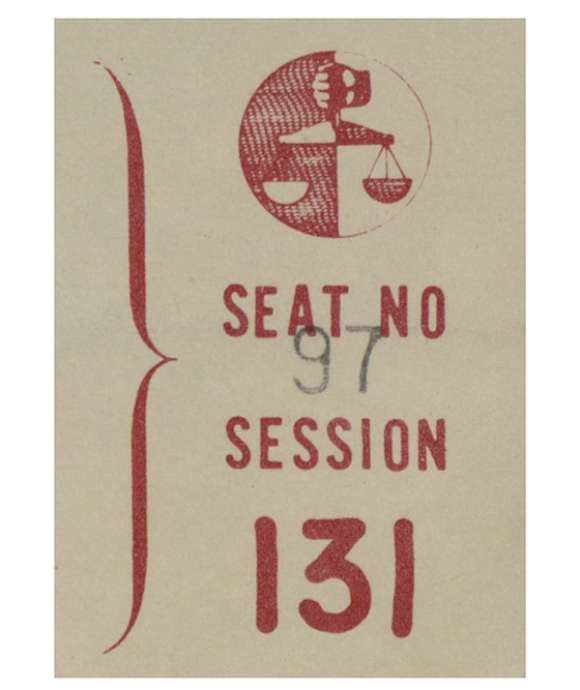
Curator's Choice: Nuremberg Trial Visitor
The courtroom of the International Military Tribunal in Nuremberg hosted nearly 400 visitors each day, including 250 members of the international press. The Museum’s collection contains items from some of these visitors, American service members who wanted to sit in on one of the most significant trials in history.
This article is part of a series commemorating the 75th anniversary of the end of World War II made possible by the Department of Defense.
Kim Guise
Kimberly Guise holds a BA in German and Judaic Studies from the University of Massachusetts Amherst. She also studied at the Universität Freiburg in Germany and holds a masters in Library and Information Science (MLIS) from Louisiana State University. Kim is fluent in German, reads Yiddish, and specializes in the American prisoner-of-war experience in World War II.
Cite this article:
MLA Citation:
APA Citation:
Chicago Style Citation:
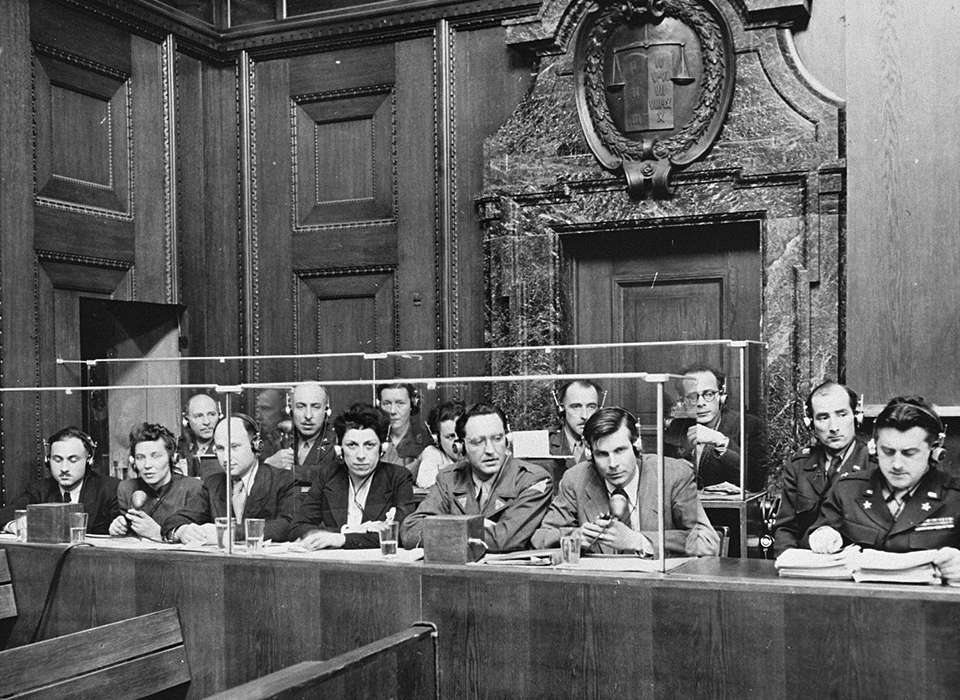
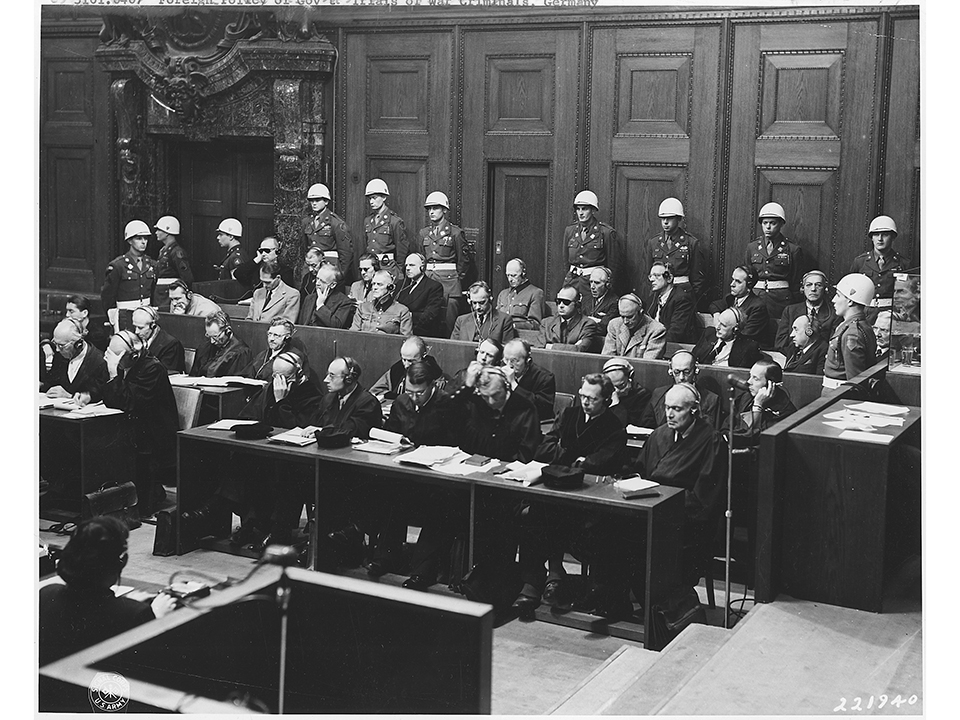
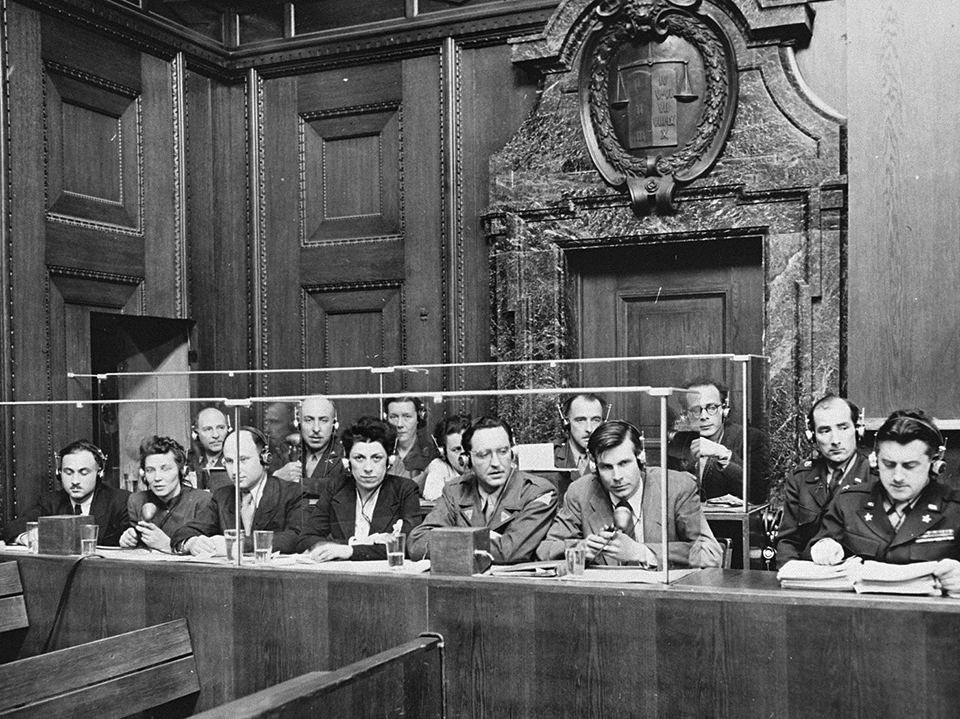
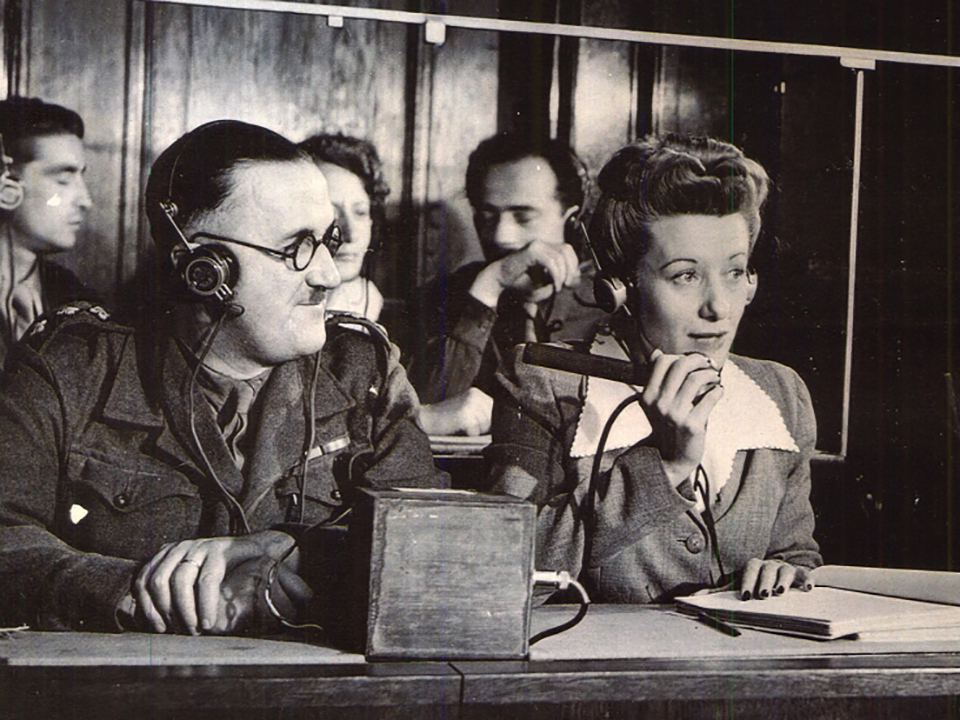
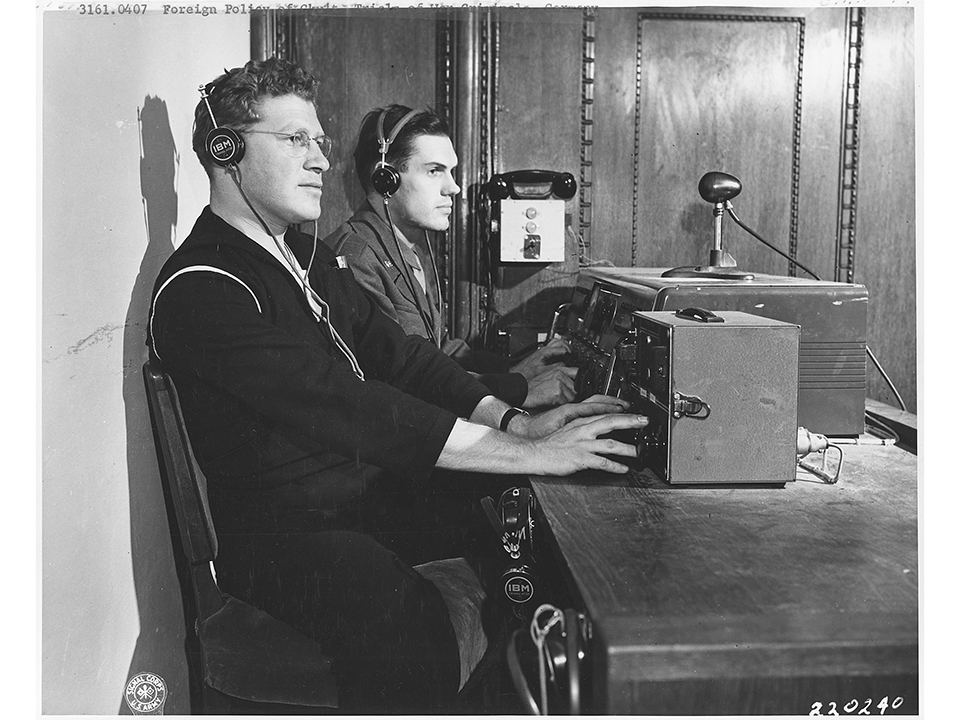



![Max Fuchs, New York City cantor, sings as Rabbi Sydney [sic] Lefkowitz, Richmond, VA, conducts the first Jewish services from Germany.](/sites/default/files/styles/max_650x650/public/2025-10/image1.jpg)


